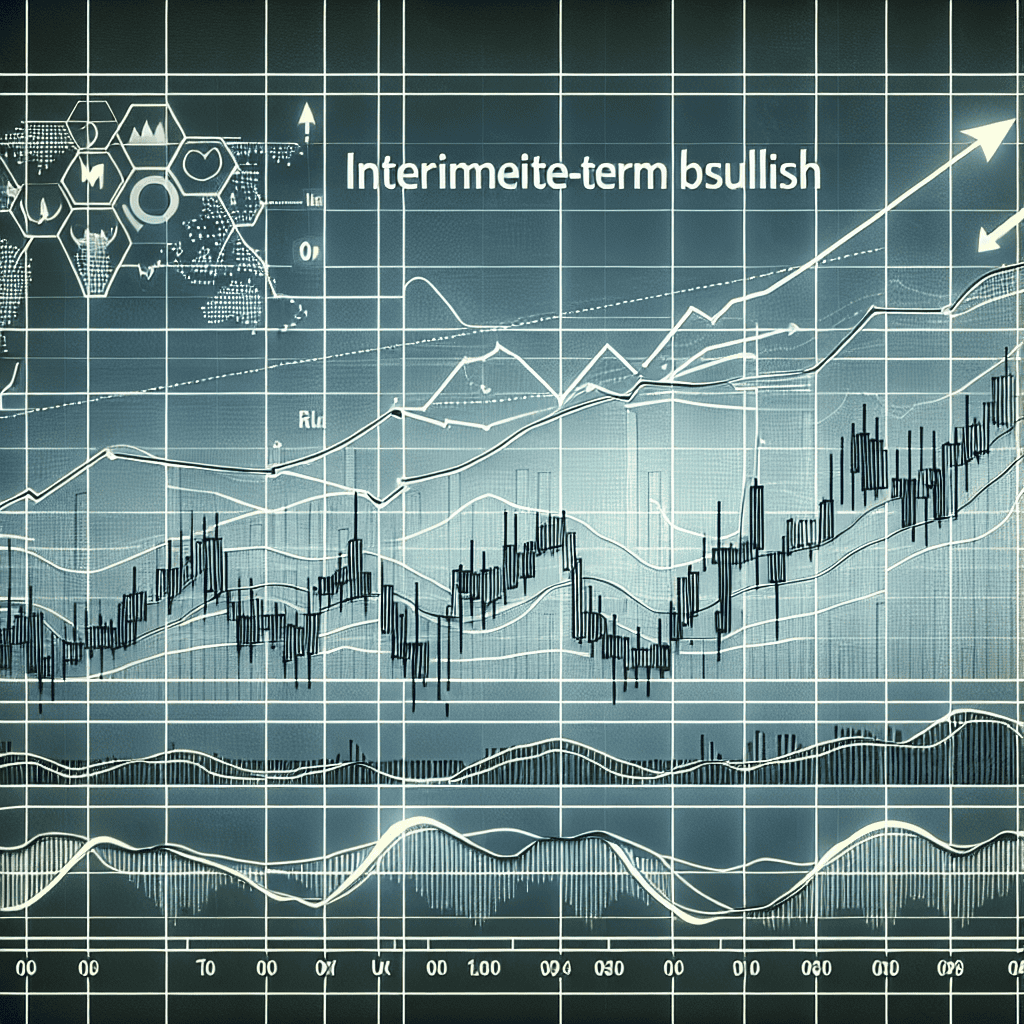“Riding the Wave: Navigating the Intermediate-Term Bullish Horizon”
Introduction
Intermediate-term bullish outlook refers to a positive expectation for asset prices over a medium time frame, typically ranging from several weeks to a few months. This perspective is often derived from technical analysis, which involves evaluating statistical trends gathered from trading activity, such as price movement and volume. Technical analysts use various tools and indicators, such as moving averages, trend lines, and momentum oscillators, to identify patterns and signals that suggest a continuation of upward price movement. A bullish outlook in this context implies that the market or specific asset is expected to experience rising prices, driven by factors such as strong demand, favorable economic conditions, or positive investor sentiment. This analysis helps traders and investors make informed decisions by providing insights into potential future price movements, allowing them to capitalize on anticipated market trends.
Understanding Intermediate-Term Bullish Patterns in Technical Analysis
In the realm of financial markets, technical analysis serves as a crucial tool for traders and investors seeking to understand price movements and forecast future trends. Among the various timeframes considered in technical analysis, the intermediate-term outlook often garners significant attention due to its balance between short-term volatility and long-term trends. An intermediate-term bullish outlook, in particular, can provide valuable insights into potential upward movements in asset prices over a period typically ranging from several weeks to a few months. Understanding the patterns and indicators that signal such an outlook is essential for making informed investment decisions.
To begin with, intermediate-term bullish patterns often emerge from a confluence of technical indicators and chart patterns. One of the most widely recognized patterns is the ascending triangle, characterized by a horizontal resistance line and an upward-sloping support line. This pattern suggests that buyers are gradually gaining strength, as evidenced by higher lows, and are likely to push the price above the resistance level. When the breakout occurs, it often signals a continuation of the upward trend, making it a reliable indicator of an intermediate-term bullish outlook.
In addition to chart patterns, moving averages play a pivotal role in identifying bullish trends. The 50-day and 200-day moving averages are particularly significant in this context. When the 50-day moving average crosses above the 200-day moving average, it forms what is known as a “golden cross.” This crossover is a strong bullish signal, indicating that the asset’s price is likely to continue rising in the intermediate term. Conversely, when the 50-day moving average remains above the 200-day moving average, it reinforces the bullish sentiment, suggesting sustained upward momentum.
Moreover, the Relative Strength Index (RSI) is another valuable tool for assessing intermediate-term bullish conditions. Typically, an RSI value above 70 indicates that an asset is overbought, while a value below 30 suggests it is oversold. However, in a bullish market, the RSI can remain elevated for extended periods without necessarily signaling an imminent reversal. Instead, a consistently high RSI may reflect strong buying pressure, supporting the case for an intermediate-term bullish outlook.
Furthermore, volume analysis can provide additional confirmation of bullish trends. An increase in trading volume accompanying a price rise often indicates strong investor interest and conviction, reinforcing the likelihood of a sustained upward movement. Conversely, a price increase on low volume may suggest a lack of enthusiasm, potentially undermining the bullish outlook. Therefore, monitoring volume patterns alongside price movements is crucial for validating intermediate-term bullish signals.
In conclusion, understanding intermediate-term bullish patterns in technical analysis requires a comprehensive approach that considers various indicators and chart patterns. By recognizing ascending triangles, monitoring moving average crossovers, analyzing RSI levels, and assessing volume trends, traders and investors can gain valuable insights into potential upward movements in asset prices. This knowledge not only aids in making informed investment decisions but also enhances the ability to navigate the complexities of financial markets. As such, mastering these technical analysis tools is indispensable for those seeking to capitalize on intermediate-term bullish opportunities.
Key Indicators Signaling a Bullish Outlook
In the realm of financial markets, technical analysis serves as a crucial tool for investors seeking to understand and predict market trends. As we delve into the intermediate-term bullish outlook, several key indicators emerge, signaling potential upward momentum in the market. These indicators, when analyzed collectively, provide a comprehensive view of the market’s current state and its prospective trajectory.
To begin with, moving averages are fundamental in technical analysis, offering insights into market trends over various time frames. The 50-day and 200-day moving averages are particularly significant. When the 50-day moving average crosses above the 200-day moving average, it forms what is known as a “golden cross,” a classic bullish signal. This crossover suggests that the market’s short-term momentum is gaining strength relative to its longer-term trend, often preceding a sustained upward movement. Observing this pattern in the current market context reinforces the intermediate-term bullish outlook.
In addition to moving averages, the Relative Strength Index (RSI) is another pivotal indicator. The RSI measures the speed and change of price movements, oscillating between zero and 100. An RSI above 70 typically indicates that a security is overbought, while an RSI below 30 suggests it is oversold. In the present scenario, an RSI that hovers around the mid-60s can be interpreted as a sign of bullish momentum without reaching overbought conditions. This balance indicates that there is still room for upward movement before the market becomes overheated.
Furthermore, the analysis of volume trends provides additional confirmation of a bullish outlook. Volume, the number of shares or contracts traded in a security or market during a given period, is a critical component of technical analysis. An increase in volume accompanying a price rise suggests strong investor interest and conviction, reinforcing the bullish trend. Conversely, a price increase on declining volume may indicate a lack of enthusiasm, potentially signaling a weaker trend. Currently, the market is experiencing rising prices with robust volume, further supporting the intermediate-term bullish perspective.
Moreover, the Moving Average Convergence Divergence (MACD) indicator offers valuable insights into market momentum. The MACD is calculated by subtracting the 26-day exponential moving average (EMA) from the 12-day EMA. A bullish signal is generated when the MACD line crosses above the signal line, indicating a potential shift in momentum. In the current market environment, the MACD has recently crossed above the signal line, suggesting a strengthening bullish trend.
Additionally, the analysis of support and resistance levels provides further context to the bullish outlook. Support levels are price points where a security tends to stop falling and may even rebound, while resistance levels are where it tends to stop rising. A breakout above a significant resistance level can signal the beginning of a new upward trend. Recently, the market has breached key resistance levels, indicating a potential shift in sentiment and paving the way for further gains.
In conclusion, the convergence of these technical indicators—moving averages, RSI, volume trends, MACD, and support and resistance levels—paints a compelling picture of an intermediate-term bullish outlook. While no single indicator can predict market movements with absolute certainty, the alignment of these signals provides a robust framework for anticipating continued upward momentum. As investors navigate the complexities of the financial markets, these technical insights offer valuable guidance in making informed decisions.
Analyzing Moving Averages for Bullish Trends
In the realm of technical analysis, moving averages serve as a fundamental tool for investors and traders seeking to identify potential bullish trends in the market. By smoothing out price data, moving averages help to filter out the noise and provide a clearer picture of the underlying trend. As we delve into the intermediate-term bullish outlook, it is essential to understand how moving averages can be effectively utilized to discern these trends.
To begin with, moving averages are calculated by averaging a set number of past data points, which can be adjusted to suit different time frames. The most commonly used moving averages are the simple moving average (SMA) and the exponential moving average (EMA). While the SMA gives equal weight to all data points, the EMA assigns greater weight to more recent prices, making it more responsive to recent market changes. This responsiveness can be particularly advantageous when analyzing intermediate-term trends, as it allows for quicker identification of potential shifts in market sentiment.
One of the primary ways moving averages are used to identify bullish trends is through the analysis of crossovers. A bullish crossover occurs when a shorter-term moving average crosses above a longer-term moving average. This event is often interpreted as a signal that the market is gaining upward momentum, suggesting a potential buying opportunity. For instance, a common strategy involves the 50-day SMA crossing above the 200-day SMA, known as the “golden cross.” This crossover is widely regarded as a strong bullish signal, indicating that the intermediate-term trend may be shifting in favor of the bulls.
In addition to crossovers, the slope of the moving average itself can provide valuable insights into the market’s direction. An upward-sloping moving average suggests that prices are generally rising, reinforcing the notion of a bullish trend. Conversely, a downward-sloping moving average may indicate a bearish trend. By observing the slope, traders can gain a better understanding of the market’s momentum and make more informed decisions.
Furthermore, moving averages can also serve as dynamic support and resistance levels. In an uptrend, prices often find support at the moving average, bouncing off it and continuing their upward trajectory. This behavior can be attributed to the psychological impact moving averages have on market participants, who may view them as key levels to watch. Consequently, when prices approach a moving average, traders often anticipate a potential reversal or continuation of the trend, providing opportunities for strategic entry or exit points.
While moving averages are a powerful tool for identifying bullish trends, it is important to acknowledge their limitations. They are inherently lagging indicators, meaning they rely on past price data and may not always accurately predict future movements. As such, it is crucial to use moving averages in conjunction with other technical indicators and analysis techniques to confirm signals and reduce the risk of false positives.
In conclusion, moving averages play a pivotal role in technical analysis, offering valuable insights into intermediate-term bullish trends. By analyzing crossovers, slopes, and their role as support and resistance levels, traders can enhance their ability to identify and capitalize on potential market opportunities. However, it is essential to remain cognizant of their limitations and to employ a comprehensive approach that incorporates multiple indicators and analysis methods. Through this balanced strategy, investors can better navigate the complexities of the market and make more informed decisions in pursuit of their financial goals.
The Role of Volume in Confirming Bullish Sentiment

In the realm of technical analysis, volume plays a pivotal role in confirming bullish sentiment, particularly when evaluating an intermediate-term outlook. As investors and traders seek to understand market dynamics, volume serves as a crucial indicator that can validate price movements and provide insights into the strength of a trend. By examining volume patterns, market participants can gain a deeper understanding of the underlying forces driving price action, thereby enhancing their ability to make informed decisions.
To begin with, it is essential to recognize that volume represents the total number of shares or contracts traded within a given period. When analyzing a bullish trend, an increase in volume often signifies heightened investor interest and participation, which can reinforce the sustainability of the upward movement. For instance, when a stock or index experiences a price increase accompanied by rising volume, it suggests that more participants are buying into the trend, thereby lending credibility to the bullish sentiment. Conversely, a price rise on declining volume may indicate a lack of conviction among investors, potentially signaling a weakening trend.
Moreover, volume can also serve as a precursor to potential trend reversals. In the context of a bullish market, a sudden spike in volume following a prolonged uptrend may suggest that the trend is nearing exhaustion. This phenomenon, often referred to as a “blow-off top,” occurs when a surge in buying activity is followed by a rapid price decline, indicating that the market may have reached a temporary peak. Therefore, monitoring volume patterns can provide early warning signals, allowing traders to adjust their positions accordingly.
In addition to confirming trends and signaling reversals, volume analysis can also be employed to identify key support and resistance levels. When a stock or index approaches a significant price level, observing the accompanying volume can offer valuable insights into the strength of that level. For example, if a security approaches a resistance level with increasing volume, it may suggest that the level is likely to be breached, as the heightened buying pressure overcomes selling interest. Conversely, if volume diminishes as the price nears resistance, it may indicate that the level will hold, as the lack of buying interest fails to propel the price higher.
Furthermore, volume can be utilized in conjunction with other technical indicators to enhance the robustness of analysis. For instance, combining volume with moving averages or relative strength index (RSI) can provide a more comprehensive view of market conditions. When a moving average crossover occurs with a corresponding increase in volume, it can serve as a stronger confirmation of a bullish trend. Similarly, when RSI indicates an overbought condition, a concurrent rise in volume may suggest that the bullish momentum is likely to continue, despite the overbought reading.
In conclusion, the role of volume in confirming bullish sentiment is multifaceted and indispensable for technical analysts seeking to navigate the complexities of the financial markets. By providing insights into the strength and sustainability of trends, as well as potential reversals and key price levels, volume analysis serves as a vital tool in the arsenal of any market participant. As such, incorporating volume into one’s analytical framework can significantly enhance the ability to make informed and strategic investment decisions, particularly in the context of an intermediate-term bullish outlook.
Identifying Bullish Reversal Patterns
In the realm of technical analysis, identifying bullish reversal patterns is a crucial skill for traders and investors aiming to capitalize on potential upward market movements. These patterns, which signal a possible shift from a downtrend to an uptrend, can provide valuable insights into market sentiment and future price action. Understanding and recognizing these patterns can significantly enhance one’s ability to make informed trading decisions.
One of the most well-known bullish reversal patterns is the “double bottom.” This pattern typically forms after a sustained downtrend and is characterized by two distinct troughs at approximately the same price level, separated by a peak. The double bottom suggests that the asset has found a strong support level, and the subsequent breakout above the peak indicates a potential reversal. Traders often look for increased volume during the breakout as confirmation of the pattern’s validity, as this suggests heightened buying interest.
In addition to the double bottom, the “inverse head and shoulders” pattern is another prominent bullish reversal indicator. This pattern consists of three troughs: a central trough (the head) that is lower than the two flanking troughs (the shoulders). The neckline, drawn by connecting the peaks between the shoulders, serves as a critical resistance level. A breakout above this neckline, especially on increased volume, signals a potential trend reversal. The inverse head and shoulders pattern is particularly favored for its reliability and the clear risk-reward ratio it offers traders.
Moreover, the “rounding bottom” pattern, also known as a saucer bottom, is a more gradual and less conspicuous bullish reversal pattern. It is characterized by a slow, rounded transition from a downtrend to an uptrend, resembling the shape of a bowl. This pattern often indicates a long-term shift in market sentiment, as it reflects a gradual accumulation phase where selling pressure diminishes and buying interest slowly builds. Traders should be patient with this pattern, as it can take a considerable amount of time to fully develop.
Furthermore, candlestick patterns also play a vital role in identifying bullish reversals. The “hammer” candlestick, for instance, is a single-candle pattern that forms after a downtrend. It features a small body with a long lower shadow, indicating that despite selling pressure during the session, buyers managed to push the price back up by the close. The hammer suggests a potential reversal, especially when confirmed by subsequent bullish price action.
Similarly, the “morning star” is a three-candle pattern that signals a bullish reversal. It begins with a long bearish candle, followed by a small-bodied candle that gaps down, and concludes with a long bullish candle that closes well into the body of the first candle. This pattern indicates a shift in momentum from sellers to buyers, suggesting that the downtrend may be coming to an end.
In conclusion, recognizing bullish reversal patterns is an essential component of technical analysis, providing traders with the tools to anticipate potential market reversals. By understanding patterns such as the double bottom, inverse head and shoulders, rounding bottom, and key candlestick formations, traders can enhance their ability to identify opportunities in the market. As with any analytical tool, it is important to use these patterns in conjunction with other indicators and market analysis to confirm signals and make well-informed trading decisions.
Using Fibonacci Retracements to Predict Bullish Movements
In the realm of technical analysis, Fibonacci retracements serve as a pivotal tool for traders and analysts aiming to predict potential bullish movements in the market. This method, rooted in the mathematical principles discovered by Leonardo Fibonacci, involves identifying key levels of support and resistance that can indicate potential reversal points. As market participants seek to capitalize on intermediate-term bullish trends, understanding how to effectively utilize Fibonacci retracements can provide a strategic advantage.
To begin with, Fibonacci retracements are based on the idea that markets will often retrace a predictable portion of a move, after which they will continue in the original direction. The most commonly used retracement levels are 23.6%, 38.2%, 50%, 61.8%, and 78.6%. These levels are derived from the Fibonacci sequence, where each number is the sum of the two preceding ones, leading to the golden ratio of 1.618, or its inverse, 0.618. When applied to price charts, these levels can help traders identify potential areas where a security might experience a reversal or a continuation of its trend.
In practice, traders begin by identifying a significant price movement, either upward or downward, and then apply the Fibonacci retracement tool to this move. By doing so, they can pinpoint potential support levels during a pullback in an uptrend or resistance levels during a bounce in a downtrend. For instance, in an intermediate-term bullish outlook, if a stock has experienced a significant upward movement, traders will look for the price to retrace to one of the Fibonacci levels before resuming its upward trajectory. This retracement provides an opportunity for traders to enter the market at a more favorable price point, with the expectation that the bullish trend will continue.
Moreover, the effectiveness of Fibonacci retracements is often enhanced when combined with other technical analysis tools. For example, when a Fibonacci level coincides with a moving average or a trendline, it can strengthen the level’s significance as a potential reversal point. Additionally, traders may look for confirmation through candlestick patterns or volume analysis to increase the probability of a successful trade. This confluence of indicators can provide a more robust framework for making informed trading decisions.
Furthermore, it is important to acknowledge that while Fibonacci retracements can be a powerful tool, they are not infallible. Market conditions, such as economic data releases or geopolitical events, can lead to price movements that defy technical predictions. Therefore, traders should employ risk management strategies, such as setting stop-loss orders, to protect against unexpected market volatility. By doing so, they can mitigate potential losses while maximizing the potential for gains.
In conclusion, Fibonacci retracements offer a valuable method for predicting bullish movements in the market, particularly in an intermediate-term context. By identifying key levels of support and resistance, traders can make more informed decisions about when to enter or exit positions. When used in conjunction with other technical analysis tools, Fibonacci retracements can enhance a trader’s ability to navigate the complexities of the financial markets. As with any trading strategy, however, it is essential to remain vigilant and adaptable, recognizing that market dynamics can shift rapidly and unpredictably.
The Impact of Market Sentiment on Intermediate-Term Bullish Trends
Market sentiment plays a pivotal role in shaping intermediate-term bullish trends, acting as both a catalyst and a barometer for investor behavior. Understanding the nuances of market sentiment is essential for investors and analysts who seek to navigate the complexities of financial markets. As we delve into the impact of market sentiment on intermediate-term bullish trends, it is crucial to recognize that sentiment is not merely a reflection of current market conditions but also a predictor of future movements.
To begin with, market sentiment is often gauged through various indicators, such as the put-call ratio, investor surveys, and the volatility index (VIX). These tools provide insights into the collective mood of investors, whether it be optimistic or pessimistic. When sentiment is overwhelmingly positive, it can drive prices higher as investors are more willing to take on risk, anticipating future gains. This optimism can create a self-fulfilling prophecy, where rising prices attract more buyers, further fueling the bullish trend.
However, it is important to note that extreme levels of positive sentiment can also signal caution. When sentiment reaches euphoric levels, it may indicate that the market is overbought, and a correction could be imminent. Therefore, while positive sentiment can support an intermediate-term bullish outlook, it is essential to monitor these indicators for signs of excessive exuberance.
In addition to sentiment indicators, technical analysis tools such as moving averages, trend lines, and momentum oscillators can provide valuable insights into the sustainability of a bullish trend. For instance, when a stock or index is trading above its moving average, it suggests that the trend is upward. Coupled with positive sentiment, this can reinforce the bullish outlook. Conversely, if sentiment remains positive but technical indicators show signs of weakening momentum, it may suggest that the trend is losing steam.
Moreover, the interplay between market sentiment and fundamental factors cannot be overlooked. Economic data releases, corporate earnings reports, and geopolitical events can all influence sentiment, either reinforcing or undermining the prevailing trend. For example, strong economic data can bolster investor confidence, supporting a bullish trend. On the other hand, unexpected negative news can quickly shift sentiment, leading to increased volatility and potential reversals.
Furthermore, the role of institutional investors in shaping market sentiment is significant. These large players often have access to more comprehensive data and sophisticated analysis tools, allowing them to anticipate market movements more accurately. Their actions can influence sentiment, as retail investors often look to institutional behavior as a guide. When institutions are bullish, it can instill confidence in the broader market, further supporting the trend.
In conclusion, while market sentiment is a powerful driver of intermediate-term bullish trends, it is not infallible. Investors must remain vigilant, continuously assessing both sentiment and technical indicators to gauge the health of the trend. By understanding the intricate relationship between sentiment, technical analysis, and fundamental factors, investors can better position themselves to capitalize on bullish opportunities while mitigating potential risks. As the market landscape evolves, maintaining a balanced perspective will be key to navigating the complexities of sentiment-driven trends.
Q&A
1. **What is an Intermediate-Term Bullish Outlook?**
An intermediate-term bullish outlook refers to a positive expectation for asset prices over a medium time frame, typically ranging from a few weeks to several months.
2. **What technical indicators are commonly used to identify an Intermediate-Term Bullish Outlook?**
Common indicators include moving averages (such as the 50-day and 200-day moving averages), Relative Strength Index (RSI), MACD (Moving Average Convergence Divergence), and trendlines.
3. **How does a moving average crossover signal a bullish outlook?**
A bullish crossover occurs when a shorter-term moving average crosses above a longer-term moving average, indicating potential upward momentum.
4. **What role does volume play in confirming a bullish outlook?**
Increased trading volume during price advances can confirm the strength of a bullish trend, suggesting strong investor interest and commitment.
5. **How can trendlines be used to support a bullish outlook?**
An upward-sloping trendline connecting higher lows can indicate a sustained bullish trend, providing support levels for potential price pullbacks.
6. **What is the significance of the Relative Strength Index (RSI) in a bullish outlook?**
An RSI reading above 50 suggests bullish momentum, while readings above 70 may indicate overbought conditions, potentially signaling a pullback.
7. **How does the MACD indicator support a bullish outlook?**
A bullish MACD signal occurs when the MACD line crosses above the signal line, suggesting increasing upward momentum and potential price gains.
Conclusion
The intermediate-term bullish outlook, as derived from technical analysis, suggests a favorable market environment characterized by upward price momentum and positive investor sentiment. Key indicators such as moving averages, trend lines, and momentum oscillators typically align to confirm this bullish stance. The presence of higher highs and higher lows in price action further supports the continuation of the upward trend. Additionally, volume analysis often reveals increased buying interest, reinforcing the strength of the bullish outlook. However, it is crucial for investors to remain vigilant for potential reversal signals or changes in market conditions that could alter this outlook. Overall, the intermediate-term bullish perspective indicates a promising period for potential gains, provided that the technical indicators continue to support the prevailing trend.





